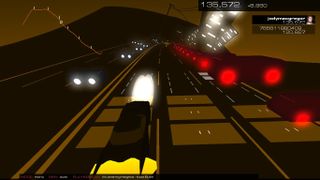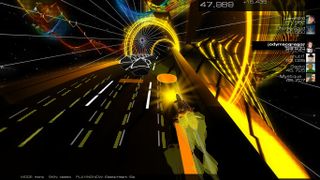A love letter to Audiosurf 2’s Dusk skin

When I was a student Winamp was the MP3 player of choice, with its fancy music visualizations that transformed your songs into wobbling oscilloscope lines or exploding starfields or psychedelic tunnels of light. As a music lover I’ve always been jealous of people who experience synesthesia, the wiring in their brains letting them connect sensory data so they see sound or hear colors. The visualizations in MP3 players were the closest I thought I’d ever get to that sensation without drugs.
Until Audiosurf came along.
Audiosurf synchronizes with a song of your choice and turns it into a twisting rollercoaster that rises as the music builds and plummets when the tempo increases, filled with colored blocks for you to dodge or collect that clump together in the song’s most intense passages. Most of the time you play as a spaceship that hurtles over these pulsing neon tracks against a backdrop of inky blackness or a sheer white void, but one of the changes in Audiosurf 2 is that it lets you select from a variety of skins, just like Winamp did. They alter the way it looks, while leaving the game underneath the surface the same.

Dusk in the wind
My favorite of these skins is Dusk, which replaces the sci-fi neon aesthetic with something much more low-key. Your spaceship becomes a car driving down a highway as the sun sets, headlights pooled in front. Admittedly you’re driving on a highway that bends into surreal shapes and contains power-ups at the start of the corkscrew loops placed at key changes and choruses, but it’s a far cry from the “this is what it’s like inside Skrillex’s mind all the time” look.
Sometimes there’s a mountain in the distance, and sometimes you drive through built-up areas with either squat dark blocks of houses or bright-windowed skyscrapers clustered together. Occasionally you cross a bridge, or an overpass will cross you. The grey blocks you dodge in Mono mode are replaced with the tail-lights of cars you swerve between as you drive toward the white light that’s your only destination at the end of the track.
It gets a little odd when I play Audiosurf 2’s wakeboard mode with the Dusk skin. In this mode, rather than trying to time it so you fill the grid behind your car (or spaceship, or little dude on skis) at precisely the moment you hit a big power-up block for bonus points, you try to fill the grid when you hit one of the song’s peaks so you can leap off the track, tricking through the air like a psychedelic Tony Hawk. It makes for an odd contrast to see your very ordinary car spinning above the highway while ‘Bangarang’ plays, but it is undeniably fun.
Something about being in a car just makes music sound better, and it’s not because of fancy subwoofers. Even the tinny speakers buzzing in the doors of my teenage friends’ cars as we’d drive up and down the main street at night–I grew up in a small town, there wasn’t much to do–sounded amazing at the time. The real world sliding past passenger windows is the original music visualization and it’s still hard to beat. In video games I get a similar enjoyment out of tooling around open world games, whether I’m listening to ‘Atomic’ by Blondie while riding a scooter through Vice City or hearing the main characters sing along to the radio in one of the Saints Row sequels.
The biggest gaming news, reviews and hardware deals
Keep up to date with the most important stories and the best deals, as picked by the PC Gamer team.
I don’t even own a car, but Audiosurf 2 lets me enjoy the head-clearing sensation of hitting the road and cranking the stereo up, getting out of town and not looking back (except for when I need check how full my grid of colored blocks is).
Fans of the Audiosurf games love to argue about which music makes for the best levels. Hyperfast dance music and metal tend to be the winners, since both create tracks full of incident and sudden flourishes of heavy traffic. Songs like Dragonforce’s deedly-deedly guitar epic ‘Through The Fire And Flames’ and Moby’s ‘10 Thousand’, named for the BPM it reaches at its peak, will give you that if it’s what you’re looking for. I’d argue that straight-up pop music creates the most interesting tracks, that strong beats, dramatic key changes, and big choruses make the kind of bouncing and spiralling Audiosurf levels that are the most fun to play, that corkscrew you off into the sunset at the precise moment the singalong bit starts. Here’s a playlist of some of my favorites, a mixtape you can put in your car next time you go driving in Dusk.
Sia, ‘Elastic Heart’
Queen, ‘Bohemian Rhapsody’ (obviously you have the entire Greatest Hits in your car, who doesn’t?)
Robyn, ‘Konichiwa Bitches’
Orange Caramel, ‘Catallena’ (K-pop is even more dynamic and full of shifts than western pop, perfect for Audiosurf)
Kylie Minogue, ‘Confide In Me’
Gary Numan, ‘Cars’
Chvrches, ‘The Mother We Share’
The Modern Lovers, ‘Roadrunner’
Ohio Players, ‘Love Rollercoaster’
Kate Bush, ‘Wuthering Heights’ (Kate Bush doesn’t know this but she’s actually one of the greatest video game level designers of all time)

Jody's first computer was a Commodore 64, so he remembers having to use a code wheel to play Pool of Radiance. A former music journalist who interviewed everyone from Giorgio Moroder to Trent Reznor, Jody also co-hosted Australia's first radio show about videogames, Zed Games. He's written for Rock Paper Shotgun, The Big Issue, GamesRadar, Zam, Glixel, Five Out of Ten Magazine, and Playboy.com, whose cheques with the bunny logo made for fun conversations at the bank. Jody's first article for PC Gamer was about the audio of Alien Isolation, published in 2015, and since then he's written about why Silent Hill belongs on PC, why Recettear: An Item Shop's Tale is the best fantasy shopkeeper tycoon game, and how weird Lost Ark can get. Jody edited PC Gamer Indie from 2017 to 2018, and he eventually lived up to his promise to play every Warhammer videogame.
Most Popular

